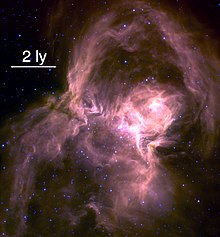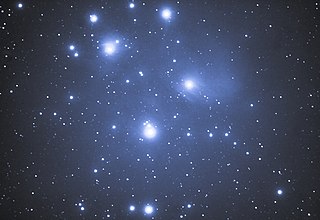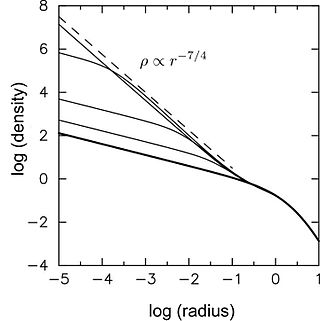
In astronomy, dynamical mass segregation is the process by which heavier members of a gravitationally bound system, such as a star cluster, tend to move toward the center, while lighter members tend to move farther away from the center.

In astronomy, dynamical mass segregation is the process by which heavier members of a gravitationally bound system, such as a star cluster, tend to move toward the center, while lighter members tend to move farther away from the center.
During a close encounter of two members of the cluster, the members exchange both energy and momentum. Although energy can be exchanged in either direction, there is a statistical tendency for the kinetic energy of the two members to equalize during an encounter; this statistical phenomenon is called equipartition, and is similar to the fact that the expected kinetic energy of the molecules of a gas are all the same at a given temperature.
Since kinetic energy is proportional to mass times the square of the speed, equipartition requires the less massive members of a cluster to be moving faster. The more massive members will thus tend to sink into lower orbits (that is, orbits closer to the center of the cluster), while the less massive members will tend to rise to higher orbits.
The time it takes for the kinetic energies of the cluster members to roughly equalize is called the relaxation time of the cluster. A relaxation time-scale assuming energy is exchanged through two-body interactions was approximated in the textbook by Binney & Tremaine [1] as
where is the number of stars in the cluster and is the typical time it takes for a star to cross the cluster. This is on the order of 100 million years for a typical globular cluster with radius 10 parsecs consisting of 100 thousand stars. The most massive stars in a cluster can segregate more rapidly than the less massive stars. This time-scale can be approximated using a toy model developed by Lyman Spitzer of a cluster where stars only have two possible masses ( and ). In this case, the more massive stars (mass ) will segregate in the time
Outward segregation of white dwarfs was observed in the globular cluster 47 Tucanae in a HST study of the region. [2]

Primordial mass segregation is non-uniform distribution of masses present at the formation of a cluster. The argument that a star cluster is primordially mass segregated is typically based on a comparison of virialization timescales and the cluster's age. However, several dynamical mechanisms to accelerate virialization compared to two-body interactions have been examined. [4] In star-forming regions, it is often observed that O-type stars are preferentially located in the center of a young cluster.
After relaxation, the speed of some low mass members can be greater than the escape velocity of the cluster, which results in these members being lost to the cluster. This process is called evaporation. (A similar phenomenon explains the loss of lighter gases from a planet, such as hydrogen and helium from the Earth—after equipartition, some molecules of sufficiently light gases at the top of the atmosphere will exceed the escape velocity of the planet and be lost.)
Through evaporation, most open clusters eventually dissipate, as indicated by the fact that most existing open clusters are quite young. Globular clusters, being more tightly bound, appear to be more durable.
The relaxation time of the Milky Way galaxy is approximately 10 trillion years, on the order of thousand times the age of the galaxy itself. Thus, any observed mass segregation in our galaxy must be almost entirely primordial.[ citation needed ]

Brownian motion is the random motion of particles suspended in a medium.

A globular cluster is a spheroidal conglomeration of stars that is bound together by gravity, with a higher concentration of stars towards their centers. They can contain anywhere from tens of thousands to many millions of member stars, all orbiting in a stable, compact formation. Globular clusters are similar in form to dwarf spheroidal galaxies, and the distinction between the two is not always clear. Their name is derived from Latin globulus. Globular clusters are occasionally known simply as "globulars".

An open cluster is a type of star cluster made of tens to a few thousand stars that were formed from the same giant molecular cloud and have roughly the same age. More than 1,100 open clusters have been discovered within the Milky Way galaxy, and many more are thought to exist. They are loosely bound by mutual gravitational attraction and become disrupted by close encounters with other clusters and clouds of gas as they orbit the Galactic Center. This can result in a loss of cluster members through internal close encounters and a dispersion into the main body of the galaxy. Open clusters generally survive for a few hundred million years, with the most massive ones surviving for a few billion years. In contrast, the more massive globular clusters of stars exert a stronger gravitational attraction on their members, and can survive for longer. Open clusters have been found only in spiral and irregular galaxies, in which active star formation is occurring.
In statistical mechanics, the virial theorem provides a general equation that relates the average over time of the total kinetic energy of a stable system of discrete particles, bound by a conservative force, with that of the total potential energy of the system. Mathematically, the theorem states

Star formation is the process by which dense regions within molecular clouds in interstellar space, sometimes referred to as "stellar nurseries" or "star-forming regions", collapse and form stars. As a branch of astronomy, star formation includes the study of the interstellar medium (ISM) and giant molecular clouds (GMC) as precursors to the star formation process, and the study of protostars and young stellar objects as its immediate products. It is closely related to planet formation, another branch of astronomy. Star formation theory, as well as accounting for the formation of a single star, must also account for the statistics of binary stars and the initial mass function. Most stars do not form in isolation but as part of a group of stars referred as star clusters or stellar associations.

Stellar dynamics is the branch of astrophysics which describes in a statistical way the collective motions of stars subject to their mutual gravity. The essential difference from celestial mechanics is that the number of body

An intermediate-mass black hole (IMBH) is a class of black hole with mass in the range 102–105 solar masses: significantly more than stellar black holes but less than the 105–109 solar mass supermassive black holes. Several IMBH candidate objects have been discovered in the Milky Way galaxy and others nearby, based on indirect gas cloud velocity and accretion disk spectra observations of various evidentiary strength.

In classical statistical mechanics, the equipartition theorem relates the temperature of a system to its average energies. The equipartition theorem is also known as the law of equipartition, equipartition of energy, or simply equipartition. The original idea of equipartition was that, in thermal equilibrium, energy is shared equally among all of its various forms; for example, the average kinetic energy per degree of freedom in translational motion of a molecule should equal that in rotational motion.

In astrophysics, dynamical friction or Chandrasekhar friction, sometimes called gravitational drag, is loss of momentum and kinetic energy of moving bodies through gravitational interactions with surrounding matter in space. It was first discussed in detail by Subrahmanyan Chandrasekhar in 1943.
A galactic halo is an extended, roughly spherical component of a galaxy which extends beyond the main, visible component. Several distinct components of a galaxy comprise its halo:
In the physical sciences, relaxation usually means the return of a perturbed system into equilibrium. Each relaxation process can be categorized by a relaxation time τ. The simplest theoretical description of relaxation as function of time t is an exponential law exp(−t/τ).

A satellite galaxy is a smaller companion galaxy that travels on bound orbits within the gravitational potential of a more massive and luminous host galaxy. Satellite galaxies and their constituents are bound to their host galaxy, in the same way that planets within our own solar system are gravitationally bound to the Sun. While most satellite galaxies are dwarf galaxies, satellite galaxies of large galaxy clusters can be much more massive. The Milky Way is orbited by about fifty satellite galaxies, the largest of which is the Large Magellanic Cloud.

In astronomy, the initial mass function (IMF) is an empirical function that describes the initial distribution of masses for a population of stars during star formation. IMF not only describes the formation and evolution of individual stars, it also serves as an important link that describes the formation and evolution of galaxies. The IMF is often given as a probability density function (PDF) that describes the probability of a star that has a certain mass. It differs from the present-day mass function (PDMF), which describes the current distribution of masses of stars, such as red giants, white dwarfs, neutron stars, and black holes, after a period of time of evolution away from the main sequence stars. IMF is derived from the luminosity function while PDMF is derived from the present-day luminosity function. IMF and PDMF can be linked through the "stellar creation function". Stellar creation function is defined as the number of stars per unit volume of space in a mass range and a time interval. For all the main sequence stars have greater lifetimes than the galaxy, IMF and PDMF are equivalent. Similarly, IMF and PDMF are equivalent in brown dwarfs due to their unlimited lifetimes.
A super star cluster (SSC) is a very massive young open cluster that is thought to be the precursor of a globular cluster. These clusters called "super" because they are relatively more luminous and contain more mass than other young star clusters. The SSC, however, does not have to physically be larger than other clusters of lower mass and luminosity. They typically contain a very large number of young, massive stars that ionize a surrounding HII region or a so-called "Ultra dense HII region (UDHII)" in the Milky Way Galaxy or in other galaxies. An SSC's HII region is in turn surrounded by a cocoon of dust. In many cases, the stars and the HII regions will be invisible to observations in certain wavelengths of light, such as the visible spectrum, due to high levels of extinction. As a result, the youngest SSCs are best observed and photographed in radio and infrared. SSCs, such as Westerlund 1 (Wd1), have been found in the Milky Way Galaxy. However, most have been observed in farther regions of the universe. In the galaxy M82 alone, 197 young SSCs have been observed and identified using the Hubble Space Telescope.

In astronomy, stellar kinematics is the observational study or measurement of the kinematics or motions of stars through space.

The type-cD galaxy is a galaxy morphology classification, a subtype of type-D giant elliptical galaxy. Characterized by a large halo of stars, they can be found near the centres of some rich galaxy clusters. They are also known as supergiant ellipticals or central dominant galaxies.

Bahcall–Wolf cusp refers to a particular distribution of stars around a massive black hole at the center of a galaxy or globular cluster. If the nucleus containing the black hole is sufficiently old, exchange of orbital energy between stars drives their distribution toward a characteristic form, such that the density of stars, ρ, varies with distance from the black hole, r, as
The Eridanus II Dwarf is a low-surface brightness dwarf galaxy in the constellation Eridanus. Eridanus II was independently discovered by two groups in 2015, using data from the Dark Energy Survey. This galaxy is probably a distant satellite of the Milky Way. Li et al., 2016. Eridanus II contains a centrally located globular cluster; and is the smallest, least luminous galaxy known to contain a globular cluster. Crnojević et al., 2016. Eridanus II is significant, in a general sense, because the widely accepted Lambda CDM cosmology predicts the existence of many more dwarf galaxies than have yet been observed. The search for just such bodies was one of the motivations for the ongoing Dark Energy Survey observations. Eridanus II has special significance because of its apparently stable globular cluster. The stability of this cluster, near the center of such a small, diffuse, galaxy places constraints on the nature of dark matter. Brandt 2016.
In cosmology, Gurzadyan-Savvidy (GS) relaxation is a theory developed by Vahe Gurzadyan and George Savvidy to explain the relaxation over time of the dynamics of N-body gravitating systems such as star clusters and galaxies. Stellar systems observed in the Universe – globular clusters and elliptical galaxies – reveal their relaxed state reflected in the high degree of regularity of some of their physical characteristics such as surface luminosity, velocity dispersion, geometric shapes, etc. The basic mechanism of relaxation of stellar systems has been considered the 2-body encounters, to lead to the observed fine-grained equilibrium. The coarse-grained phase of evolution of gravitating systems is described by violent relaxation developed by Donald Lynden-Bell. The 2-body mechanism of relaxation is known in plasma physics. The difficulties with description of collective effects in N-body gravitating systems arise due to the long-range character of gravitational interaction, as distinct of plasma where due to two different signs of charges the Debye screening takes place. The 2-body relaxation mechanism e.g. for elliptical galaxies predicts around years i.e. time scales exceeding the age of the Universe. The problem of relaxation and evolution of stellar systems and the role of collective effects are studied by various techniques, see. Among the efficient methods of study of N-body gravitating systems are the numerical simulations, particularly, Sverre Aarseth's N-body codes are widely used.
NGC 7492 is a globular cluster in the constellation Aquarius. It was discovered by the astronomer William Herschel on September 20, 1786. It resides in the outskirts of the Milky Way, about 80,000 light-years away, more than twice the distance between the Sun and the center of the galaxy, and is a benchmark member of the outer galactic halo. The cluster is immersed in, but does not kinematically belong to, the Sagittarius Stream.